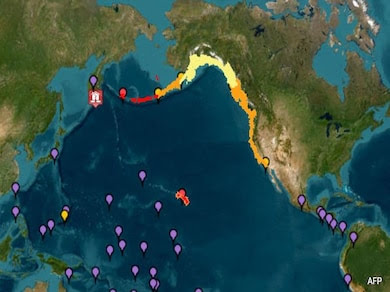
July 30, 2025 | International Desk
A massive magnitude 8.8 earthquake—one of the strongest recorded globally in recent years—struck Russia’s far eastern Kamchatka Peninsula in the early hours of Wednesday, triggering tsunami waves and widespread emergency alerts across the Pacific region.
The powerful undersea quake caused tsunami waves up to 4 meters (13 feet) high, damaging infrastructure and prompting mass evacuations in parts of Russia, Japan, the United States, and several other countries. “Today’s earthquake was extremely serious—one of the strongest in decades,” said Kamchatka Governor Vladimir Solodov in a statement shared on Telegram. He confirmed damage to several structures, including a local kindergarten.
🌊 Tsunami Reaches Pacific Nations
The first tsunami wave struck Severo-Kurilsk, the main settlement on Russia’s Kuril Islands, with subsequent waves of 3–4 meters recorded in coastal Kamchatka.
In Japan, the Japan Meteorological Agency confirmed a 30-centimeter tsunami wave reached Nemuro on the eastern coast of Hokkaido. Though the impact was minimal, authorities maintained heightened coastal surveillance.
Tsunami warnings were also issued for Alaska, Hawaii, Chile, the Solomon Islands, and as far south as New Zealand, as seismic waves rippled across the northern Pacific basin. In Ecuador, forecasters warned that waves over 3 meters were possible in certain coastal areas.
🧭 Epicenter and Impact Zone
The epicenter of the quake was located approximately 119 kilometers (74 miles) from Petropavlovsk-Kamchatsky, a city of over 180,000 residents on the Kamchatka Peninsula. The depth of the earthquake and its proximity to densely populated coastal regions raised immediate concern, but no fatalities have been reported as of this publication.
Authorities across the Pacific urged residents in vulnerable zones to evacuate low-lying areas and remain alert for aftershocks and additional wave activity.
🌐 Global Alerts & Monitoring
Emergency agencies and meteorological departments worldwide, including Russia’s Ministry of Emergency Situations, Japan’s Meteorological Agency, NOAA in the U.S., and the Pacific Tsunami Warning Center, are closely monitoring the situation.
Although early reports suggest limited structural damage and no loss of life, officials are conducting detailed assessments. The threat of aftershocks and potential secondary quakes remains high.
